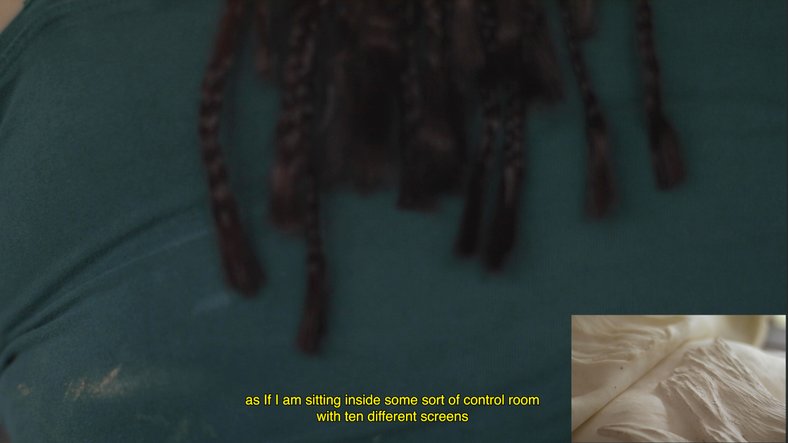18 NOV, 2023 - 20 JAN, 2024
A DUO EXHIBITION BY
BERNKE KLEIN ZANDVOORT & LUCÍA HINOJOSA GAXIOLA
18 NOV 2023 | 5 PM
OPENING
/ SOUND PERFORMANCE of Letters to Unknown Letters:
Micro-improvisations for headphones by Lucía Hinojosa Gaxiola & Enrique Arriaga
// COLLECTIVE READING by Bernke Klein Zandvoort, Lucía Hinojosa Gaxiola, Jo Ying Peng in collaboration with Kara Rooney and Renata Del Riego
30 NOV 2023 | 8 PM
PARTICIPATORY PERFORMANCE of Rewritings of Invocation
13 JAN 2024 | 5 PM
GUIDED TOUR with the artists
20 JAN 2024 | 5 PM
CLOSING: POETRY READING
/ Collective reading by Bernke Klein Zandvoort, Lucía Hinojosa Gaxiola, Jo Ying Peng in collaboration with Kara Rooney and Renata Del Riego
// Letters to Unknown Letters by Lucía Hinojosa Gaxiola
Editing and translation: Diego Gerard Morrison, Lucy Pawlak
Production: Laurie Abad, Enrique Arriaga
Celis, Ollin Miranda, Todo Woooow
Documentation: Aimée Suárez
EYE AS AN ORACLE
BERNKE KLEIN ZANDVOORT
Two-channel video installation with blinds, projectors, tripods, speakers, 2023
Camera: Kyulim Kim, Annelein Pompe, Bernke Klein Zandvoort
Sound recording: Andrès Garcia Vidal, Achiel van den Abeele
Sound design and mix: Andrès Garcia Vidal
Music: Enrique Arriaga Celis (adaptation of O Virtus Sapientie Alio Modo by Hildegard von Bingen)
Edit: Bernke Klein Zandvoort, Bram Ruiter
Color correction: Bram Ruiter
Typography: Nuno Beijinho
Translation: Laura Schuster, Michael Mariaud García
Thanks to: Marion Algra, Mei Lan Ng, Floris de Lange, Donders Institute for Brain,
Cognition and Behaviour, Frédérique Bak Oogprothesen, Rik van Duijn, Lea-Maria
Schmitt, Mandy Bartsch, Rodrigo Red Sandoval.
THIS PROJECT IS MADE WITH THE SUPPORT OF AFK, MONDRIAAN FONDS, STICHTING STOKROOS.
THE ROPE FROM SENSE TO SENSE
BERNKE KLEIN ZANDVOORT
Single-channel video installation, 2023
Musicians: Rafael Basquez Aguirre, Juan Jesús Ocampo Flores, Carlos Aguilar Camacho, Luis Alberto Rivas Lara
Camera: Dan Sánchez Díaz Vildósola
Sound recording: Enrique Arriaga Celis
Sound design: Enrique Arriaga Celis
Sound master: Enrique Arriaga Celis, Rodrigo Esquivel
Sound mix: Rodrigo Esquivel
Song: Juan Jesús Ocampo Flores, Bernke Klein Zandvoort
Edit: Andrea Rodea / Rhizomes Films, Bernke Klein Zandvoort
Color correction: Andrea Rodea
Translation: Diego Gerard Morrison
Thanks to: Rodrigo Red Sandoval, Tuna@Radio Nopal
THIS PROJECTIS MADE WITHTHE SUPPORT OF MONDRIAAN FONDS, AND THE DUTCH EMBASSY IN MEXICO.
Letters to Unknown Letters
Lucía Hinojosa Gaxiola
Sound sculpture (headphones, leaves, rocks, found objects, lightbox). 20 minutes on loop. 2023. (The sound sculpture will be activated through a performance and a “concert for headphones”.)
Field recordings: Lucía Hinojosa Gaxiola
Sound editing: Lucía Hinojosa Gaxiola, Raúl Zetina, and Santiago Parra
Mixed and mastered: Pedro y el Lobo Sound Studio, Mexico City.
Thanks to: Darinko Chimal and Lucía Meliá Maestro.
*The poem Letters to Unknown Letters was originally published in The Minutes, a publication by the The Hildegard von Bingen Society for Gardening Companions.
Rewritings of Invocation
Lucía Hinojosa Gaxiola
Performance, sound works, archival installation, 2023
Facilitators: Lucía Hinojosa Gaxiola, Marisa Naina, Natalia Hernández Morales
Performers for Experimental Choir: Natalia Hernández Morales, María del Pilar Morales Rayón, Eugenia Suárez Rodríguez, Itzel Nallely Castillo Espinosa, Nuns and caregivers from Casa Cuna La Paz: Inocencia, María, Cristabel, Amelia, Delia, Mercedes, Martina, Asunción, Aurea Luz, Carmen, Guadalupe.
Score design: Lucía Hinojosa Gaxiola y Tatina Vázquez Estrada
Thanks to: Ruta del Castor, Fernanda Angulo, Sofía Casarín, Andrea de la Torre, Casa Cuna La Paz, Ex-Convento de Santa Mónica, The Hildegard von Bingen Society for Gardening Companions, Sophie Sieta, Naomi Woo, Emilio Hinojosa Carrión, Alejandro Quiróz, Diego Gerard Morrison, José Antonio Hinojosa, Chloe Zimmerman






